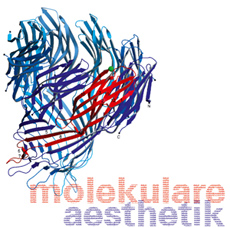| Symposium |
|
In the words of Frank Lloyd Wright, the famous architect, we can describe the modern aesthetics of the industrial society as »Machinery, Materials and Men« (Kahn Lectures, 1931). In the postindustrial age, we just have to replace the words »machinery« and »materials« by the words »media« and »molecules« and we know that we are entering the age of »La révolution moléculaire« that the French philosopher and psychoanalyst Félix Guattari proclaimed already in 1977. Molecular aesthetics represents today that what was in the Bauhaus of the 1920s called “materials research”. New industrial materials, such as metals, alloys, ceramics and acrylic glass, were then used as raw materials. However, they were defined by their macro properties. Today, through the developments in nanotechnology, materials research is able to expand into the molecular realm. The modern computer-based technology has enabled insight into matter far beyond existing conceptions, namely into the world of molecules, atoms and subatomic particles. Ways of gaining knowledge today transcend sensorial perception. The classical definition of aesthetics is bound to aisthesis, the greek word for aesthetics, that means perception. But what happens to aesthetics if with the help of machines we transcend the limits of natural perception? Then aesthetic knowledge can be attained through the employment of theories, concepts and technological experimentations. The classical aesthetic was restricted to the perception of surfaces, textures and shapes, which could be processed by the eye. It had developed its definition of beauty on the basis of the anatomy of man (see Leonardo da Vinci's »The Vitruvian Man«, 1492). Today, science has advanced through the anatomical surface into microscopic realms and we perceive new matter particles, magnitudes, proportions and scales. Doesn't this necessitate that we base our definition of aesthetics on these new dimensions? With the help of new technologies, we are able to go beyond the surface and into new zones of visibility and audibility. Therefore, we no longer deal with macroscopic, but with microscopic phenomena, which require the use of a technology driven apparatus, not of natural sensory apparatus. By the apparatus-supported perception of molecules and the process of interpretation of its visual and acoustic data, we are expanding the realm of aesthetics beyond sensory perception. Within this extension of sensory to un-sensory perception, from objects hitherto invisible and non-audible to sensory perception to objects now visible and audible with the help of instruments, aesthetics does not go astray, but rather the field of aesthetics extends to until now invisible and non-audible zones, which can finally be perceived. Molecular aesthetics as a term can be understood as a virtual field, which arose from our ability to visualize matter on a molecular nano level. By cooperating with the DFG-Center for Functional Nanostructures (CFN), which focuses on the study of nanostructures with specific and dedicated functionality, the ZKM will try to initiate a potential way for art to gain access and draw inspiration from the molecular sciences, and for molecular science to obtain means of socially articulating their experimental results.  |

